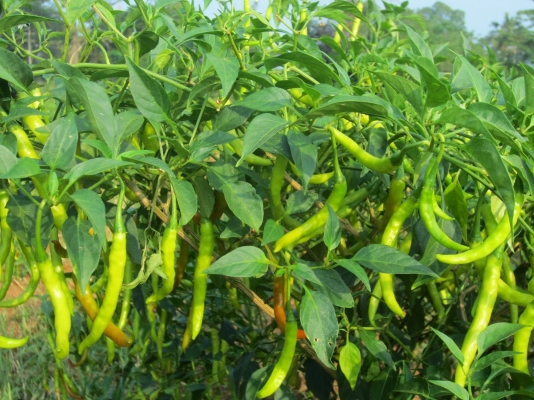
Chilli, also called the chilli pepper, is a spice used in preparing dishes. We commonly add chilli as an ingredient in foods to spice up the preparation. It originated from Mexico and is used worldwide as an ingredient in food preparation and medicines. We can also say that Chilli makes the food delicious.
Not only India is the largest producer but also the largest consumer of chillies in the world. India tops the world in chilli production, followed by China, Peru, Spain and Mexico. Some large-sized peppers are called bell peppers and are used as a vegetable.
Chilli cultivation is a good vegetable farming business. Farmers can cultivate the chilli crop as an intercrop or as a standalone chilli plantation.
We guide some essential points in the chilli cultivation process, such as which equipment farmers can use in chilli farming. We suggest the Swaraj 744 Tractor for this farming because this tractor offers the best features at a fair price.
Economic Importance of Chilli Cultivation
We most commonly use the chillies in the kitchen. Due to the presence of capsaicin, chillies have a pungent but pleasant taste, which is why it is important in the kitchen. It is also a good source of oleoresin, a major flavouring agent in the food processing industry. Oleoresin is extracted from chillies and exported to European countries. We can also use the chilli in skin ointments and prickly heat powder.
Botanical Information of Chilli or Mirchi Plant
Belonging to the Solanaceae family, chilli or chilli is botanically called capsicum annual. It is a small, annual shrub with an erect, branched shoot. It has a tap root system with simple leaves. The flowers are small, white in colour and pendulous. In other words, unlike other plants, pepper flowers fall and hang like pendants. Chilli fruits also hang downwards in the same way. The fruit contains chilli seeds. In India, chilli has various local names such as Lanka, Mirchi etc.
Climatic Requirements
Chilli is a tropical and subtropical plant that requires a combination of hot, humid but dry weather. It requires warm and humid weather during the growth phase. However, dry weather is suitable for fruit maturation.
The temperature range of 20⁰C-25⁰C is ideal for the growth of chillies. At 37⁰C or more, fruit development is affected.
Similarly, in case of heavy rains, planting wilts and rots. However, the bud does not develop properly in conditions of low moisture during the fruiting period.
Soil For Chilli Cultivation
Chillies need moisture for growth. The black soil, which retains moisture, is ideal when farmers grow rainfed crops. Under irrigated conditions, the crop needs well-drained sandy loam with rich organic content. They can also grow the chillies in deltaic soil under irrigated conditions. In hilly areas like Uttarakhand, farmers mix the soil with gravel and coarse sand before cultivating chilli.
The Season For Chilli Farming
Farmers can cultivate the chillies both as Kharif and Rabi crops. In addition, they can also plant the chillies at other times. Sowing months are May to June for the Kharif crop, September to October for Rabi crops. If they plant the chillies as summer crops, then choose the January-February months.
Water for Green Chilli Cultivation
Chillies are crops that cannot tolerate too much water. Plants can rot due to heavy rain and stagnant water. In the case of irrigating crops, farmers should give the water only when required. Frequent watering will speed up flowering and vegetative growth.
The number of irrigations and their frequency highly depends on climatic conditions and soil type. For example, if the leaves start falling during the day, it is a sign of a need for water. Similarly, if the flowers seem weak or do not show enough vigour, irrigating the crop will help. Some farmers irrigate the field when the soil moisture becomes less than 25%.
Planting Material for Chilli Plantation
At the time of cultivation, farmers must choose disease-free, good quality seeds. Moreover, it must obtain farms certified by the central authority, in the case of organic farming. Research institutes and different organizations develop the various high yielding, disease-resistant varieties.
Land Preparation for Chilli Cultivation
For chilli cultivation, the land is ploughed 2-3 times and well ploughed. Farmers should remove the gravel, stones and other such unwanted material present in the soil. If they are sowing the seed directly into the soil, it is done with the last tillage cycle. However, farmers should disinfect the soil at tillage to check for disease affecting the plant.
We are here to guide you about chilli cultivation equipment. Thus we suggest the Swaraj 744 XT tractor for chilli farming as well as we can discover the implements, which are reliable for every Indian farmer.
For more information and inquiry regarding chilli farming and any other farming, stay tuned with us.





